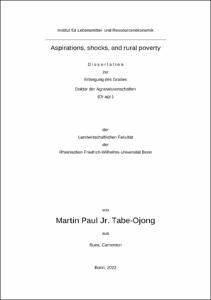Aspirations, shocks, and rural poverty

Aspirations, shocks, and rural poverty

| dc.contributor.advisor | Heckelei, Thomas | |
| dc.contributor.author | Tabe-Ojong, Martin Paul Jr. | |
| dc.date.accessioned | 2022-11-22T09:52:23Z | |
| dc.date.available | 2022-11-22T09:52:23Z | |
| dc.date.issued | 22.11.2022 | |
| dc.identifier.uri | https://hdl.handle.net/20.500.11811/10457 | |
| dc.description.abstract | Poverty remains a persistent problem in many parts of the world, especially in sub-Saharan Africa (SSA). In this region, poverty is particularly prevalent in rural areas. Further exacerbating the high levels of poverty is the COVID-19 crisis, threatening to reverse years of development efforts and progress. The existence of poverty traps in Africa has so far been attributed to major external constraints such as climate change, conflict, lack of infrastructure, gender inequality, and deep-seated structures such as over-reliance on natural resources. While acknowledging the above external constraints, internal constraints may also contribute to poverty. Individual aspirations may break or sustain behavioural poverty traps. Aspirations are defined as goals that individuals invest time, money, and effort to achieve. They are future-oriented and exclude present-level gratification. This thesis delves into understanding the formation and impact of aspirations using a survey of 530 smallholder farm households in Kenya. Aspirations regarding income, assets, social status, education and livestock as well as an aspiration index are considered. In addition, the thesis examines COVID-19-induced food insecurity and the various coping strategies households are using to get on with disruption of food access. Here, a follow-up phone survey is combined with a joint baseline survey in Kenya, Namibia and Tanzania. Most prominently, econometric, regression-type techniques are employed to address the specific research questions complemented by different tests and state-of-the-art methodological frameworks to identify relevant data-generating mechanisms. The thesis is divided into an introduction and five main chapters. Chapter two examines the formation of aspirations, looking at the role of circumstantial factors, specifically ecological shocks. Chapter three explores the role of collective action through cooperative membership, and the effect of role models on income and asset aspirations. Chapter four considers membership in religious institutions and religiosity and how this relates to the educational aspirations of parents for their children. In chapter five, the relationship between aspiration gaps (distance between current state and aspirations) and investments is considered focusing on livestock. Finally, chapter six documents the level of food insecurity, highlights disruptions in agricultural activities and food access related to COVID-19 and examines related coping strategies of households in Kenya, Namibia and Tanzania. We find aspirations to be negatively correlated with ecological shocks. Specifically, the spread of the invasive, Prosopis juliflora is shown to induce economic adversity, reducing the aspirations of households. We also find income and asset aspirations to be associated with membership in cooperative groups. This association is likely driven by role models. Still in the line of social networks, membership in religious institutions and religiosity also exhibit a positive relationship with the educational aspirations of parents for their children. These three chapters strengthen the notion that aspirations are socially constructed but also driven by circumstantial factors such as shocks and material endowments. We then confirm an inverse U-shaped relationship between aspiration gaps and livestock in Kenya. Livestock investments and savings increase with aspiration gaps up to a threshold, from which they then decline, leading to an aspiration failure. For the COVID-19 study in the three countries, households report high levels of food insecurity and disruptions of food access. Households respond to food-access disruptions by employing coping strategies such as reducing food intake, diversifying food sources towards less nutritious foods, intensifying food search, receiving government and humanitarian support, and receiving help from family and peers. Put together, this thesis confirms the importance of aspirations for future-oriented and possibly poverty-reducing behaviour. It contributes to the understanding of how they are formed but also guards against a narrow focus on aspirations given the non-monotonic relationship between aspirations and future-oriented behaviour. | en |
| dc.language.iso | eng | |
| dc.rights | In Copyright | |
| dc.rights.uri | http://rightsstatements.org/vocab/InC/1.0/ | |
| dc.subject | Aspiration formation | |
| dc.subject | ökologische Schocks | |
| dc.subject | kollektives Handeln | |
| dc.subject | Vorbilder | |
| dc.subject | Religiosität | |
| dc.subject | Aspiration failure | |
| dc.subject | Viehbestand | |
| dc.subject | COVID-19 | |
| dc.subject | Ernährungssicherheit | |
| dc.subject | Ecological shocks | |
| dc.subject | Collective action | |
| dc.subject | Role models | |
| dc.subject | Religiosity | |
| dc.subject | Livestock | |
| dc.subject | Food security | |
| dc.subject.ddc | 630 Landwirtschaft, Veterinärmedizin | |
| dc.title | Aspirations, shocks, and rural poverty | |
| dc.type | Dissertation oder Habilitation | |
| dc.publisher.name | Universitäts- und Landesbibliothek Bonn | |
| dc.publisher.location | Bonn | |
| dc.rights.accessRights | openAccess | |
| dc.identifier.urn | https://nbn-resolving.org/urn:nbn:de:hbz:5-68823 | |
| dc.relation.doi | https://doi.org/10.1057/s41287-021-00411-2 | |
| dc.relation.doi | https://doi.org/10.1016/j.wdp.2021.100349 | |
| dc.relation.doi | https://doi.org/10.1111/agec.12709 | |
| ulbbn.pubtype | Erstveröffentlichung | |
| ulbbnediss.affiliation.name | Rheinische Friedrich-Wilhelms-Universität Bonn | |
| ulbbnediss.affiliation.location | Bonn | |
| ulbbnediss.thesis.level | Dissertation | |
| ulbbnediss.dissID | 6882 | |
| ulbbnediss.date.accepted | 30.11.2021 | |
| ulbbnediss.institute | Landwirtschaftliche Fakultät : Institut für Lebensmittel- und Ressourcenökonomik (ILR) | |
| ulbbnediss.fakultaet | Landwirtschaftliche Fakultät | |
| dc.contributor.coReferee | Börner, Jan | |
| ulbbnediss.contributor.orcid | https://orcid.org/0000-0002-6546-9921 | |
| ulbbnediss.contributor.gnd | 1237325595 |
Dateien zu dieser Ressource
Das Dokument erscheint in:
-
E-Dissertationen (1116)




